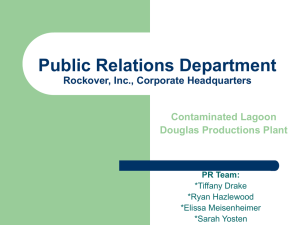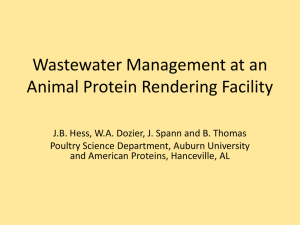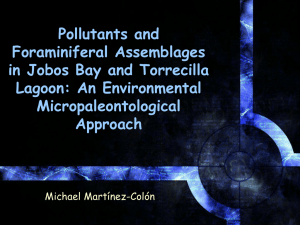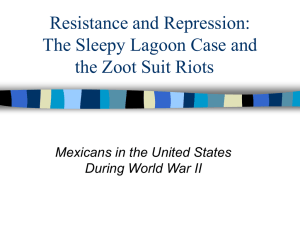Diagnosing Wastewater Lagoon Problems
advertisement
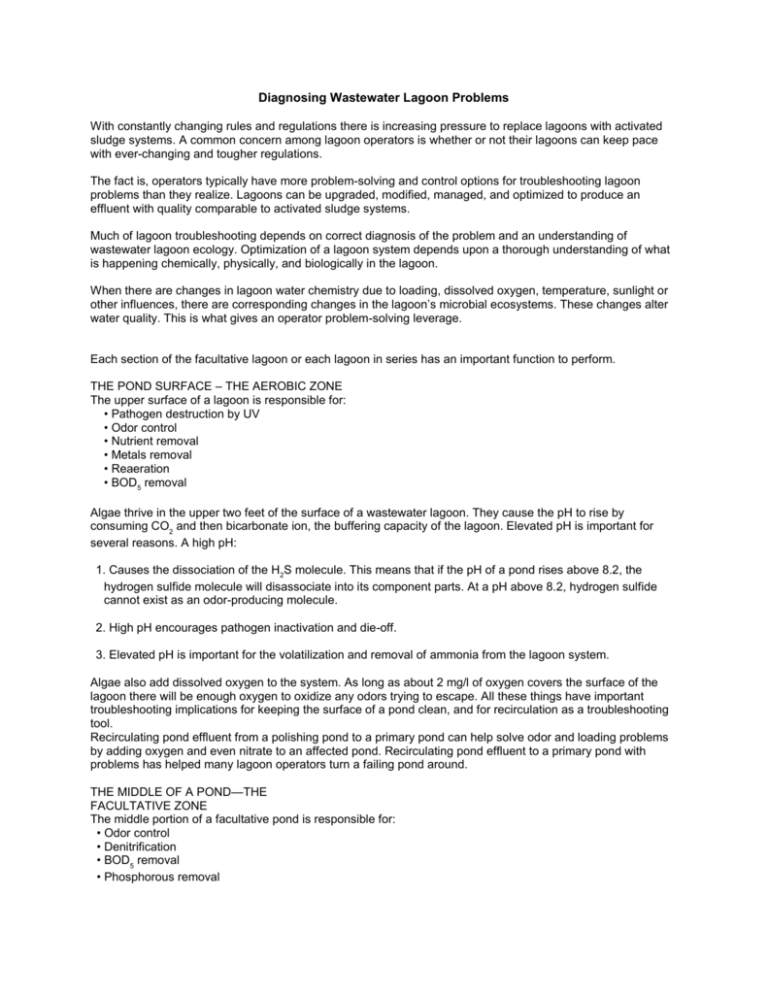
Diagnosing Wastewater Lagoon Problems With constantly changing rules and regulations there is increasing pressure to replace lagoons with activated sludge systems. A common concern among lagoon operators is whether or not their lagoons can keep pace with ever-changing and tougher regulations. The fact is, operators typically have more problem-solving and control options for troubleshooting lagoon problems than they realize. Lagoons can be upgraded, modified, managed, and optimized to produce an effluent with quality comparable to activated sludge systems. Much of lagoon troubleshooting depends on correct diagnosis of the problem and an understanding of wastewater lagoon ecology. Optimization of a lagoon system depends upon a thorough understanding of what is happening chemically, physically, and biologically in the lagoon. When there are changes in lagoon water chemistry due to loading, dissolved oxygen, temperature, sunlight or other influences, there are corresponding changes in the lagoon’s microbial ecosystems. These changes alter water quality. This is what gives an operator problem-solving leverage. Each section of the facultative lagoon or each lagoon in series has an important function to perform. THE POND SURFACE – THE AEROBIC ZONE The upper surface of a lagoon is responsible for: • Pathogen destruction by UV • Odor control • Nutrient removal • Metals removal • Reaeration • BOD5 removal Algae thrive in the upper two feet of the surface of a wastewater lagoon. They cause the pH to rise by consuming CO2 and then bicarbonate ion, the buffering capacity of the lagoon. Elevated pH is important for several reasons. A high pH: 1. Causes the dissociation of the H2S molecule. This means that if the pH of a pond rises above 8.2, the hydrogen sulfide molecule will disassociate into its component parts. At a pH above 8.2, hydrogen sulfide cannot exist as an odor-producing molecule. 2. High pH encourages pathogen inactivation and die-off. 3. Elevated pH is important for the volatilization and removal of ammonia from the lagoon system. Algae also add dissolved oxygen to the system. As long as about 2 mg/l of oxygen covers the surface of the lagoon there will be enough oxygen to oxidize any odors trying to escape. All these things have important troubleshooting implications for keeping the surface of a pond clean, and for recirculation as a troubleshooting tool. Recirculating pond effluent from a polishing pond to a primary pond can help solve odor and loading problems by adding oxygen and even nitrate to an affected pond. Recirculating pond effluent to a primary pond with problems has helped many lagoon operators turn a failing pond around. THE MIDDLE OF A POND—THE FACULTATIVE ZONE The middle portion of a facultative pond is responsible for: • Odor control • Denitrification • BOD5 removal • Phosphorous removal THE BOTTOM OR ANAEROBIC PORTION OF A LAGOON • BOD5 removal • Sludge storage • Sludge digestion • Denitrification • Pathogen destruction • Metals and nutrient storage Retention time is critical to pond performance because so many of a lagoon’s stabilization processes require contact time between the biomass and the many biological and chemical stabilizing influences that exist in a pond. Things like ultra violet radiation, predatory forces, competitive exclusion, starvation, sedimentation and natural die-off all require time. Because of this, BOD reduction, pathogen control, and TSS problems are closely linked to a pond’s retention time. Many wastewater lagoons in use today were designed at a time when the principals of lagoon hydraulics were poorly understood. Today with modern tools like computational fluid dynamics (CFD) the flow of water through a wastewater lagoon can be modeled and then optimized for improved water quality. This is important because so much of a lagoon’s ability to stabilize wastewater is dependent upon that wastewater’s exposure to the stabilizing influences of a lagoon. Far too many lagoons in use today have low retention times because of short-circuiting. Hydraulic retention time in a pond is critical because it affects the following: 1. Nitrogen removal 2. Pathogen destruction 3. Algae growth 4. BOD5/COD removal The following tests and calculations are recommended for diagnosing and solving BOD, TSS, and shortcircuiting problems. DIAGNOSING LAGOON PROBLEMS There are several different ways of looking at the BOD5 test. A few simple modifications to the BOD5 test will yield a wealth of diagnostic information. • BOD5 Regular Five Day BOD5. A standard used to measure the strength of wastewater. BOD5 = CBOD5 + NBOD5. Used as a standard, also used as a testing starting point to understand more about what is going on in a lagoon system. The BOD5 test is needed to calculate NBOD5; an indication of a lagoon’s ability to nitrify. • SBOD5/Filtered BOD5. Also called a Soluble BOD5. In this test the BOD5 test sample is first run through a TSS filter. The SBOD5 is the most readily oxidizable portion of the wastewater sample. SBOD5 = SCBOD5 + SNBOD5. Rich (1999). SBOD5 is used to calculate SCBOD5 “…it is unusual to see SBOD5 in the effluent greater than 20% of the total.” Richard & Bowman (1991). • CBOD5 Carbonaceous Biological Demand. CBOD5 is the BOD5 test run with a nitrification suppressant added to inhibit nitrification’s effect on dissolved oxygen in the BOD5 test bottle. CBOD5 = BOD5-NBOD5. CBOD5 is a better measure of a lagoon’s ability to stabilize waste. • NBOD5 = BOD5-CBOD5. NBOD5 represents the relative number of nitrifying bacteria in the BOD test bottle. Rich (1999). • SCBOD5: Soluble Carbonaceous BOD5. The BOD5 test is run after it is filtered and the nitrification suppressant is added. SCBOD5 reveals the influence of a lagoon’s sludge blanket in feeding BOD back to the water column (Benthal Feedback). Also used with CBOD5 to determine algae’s effect on the BOD5 test (see PBOD5 below). • PBOD5 = CBOD5 – SCBOD5. A PBOD > 70% of the BOD5 in the effluent indicates a solids loss problem. Richard & Bowman (1991). Also assumed to be algae’s influence on the BOD5 test result. NBOD can comprise up to 80% of the BOD5 test result! In some cases the State will allow the use of CBOD5. TSS is not the result of algae alone but can composed of many different things. • TSS = BTSS + ATSS + MTSS • BTSS is suspended bacterial solids. • ATSS is the algal component of TSS. • MTSS is silt, clay, cell debris, bottom solids. If a lagoon system is experiencing TSS problems it is a good idea to look under the microscope to get an idea of what exactly is causing the problem. Solids types lost to the effluent can include: • Raw wastewater solids in the effluent caused by short-circuiting, poor choice or placement of aeration. • Old sludge particles lost to the effluent. This may indicate too much aeration, mixing, or turbulent conditions. • Treatment Solids (bacterial flocs). This is an indication of organic overload or sludge accumulation. • Filamentous Bacteria. These may indicate low D.O. or septicity. • Sulfur Bacteria. These indicate anoxic conditions and the formation of sulfides. • Algae or Protozoa. TESTING PROCEDURES Test the BOD, TSS, and ammonia between each lagoon in series. Perhaps one pond is adding to the problem. Test dissolved oxygen levels at different times during the day, at different places throughout the lagoon, and at different depths. REFERENCES: Bowman R.D., (1991) Troubleshooting the Aerated and Facultative Waste Treatment Lagoon. A paper presented at the USEPA’s Natural/Constructed Wetlands Treatment Systems Workshop, Denver, CO. September, 1991. Rich, L.G. (1999) High Performance Aerated Lagoon Systems. American Academy of Environmental Engineers, Annapolis, Maryland. ISBN 1-883767-27-X Richard, M.G. and Bowman, R. (1991) Troubleshooting the Aerated and Facultative Waste Treatment Lagoon, Presented at the U.S. EPA’s Natural/Constructed Wetlands Treatment Systems Workshop, Denver, CO. For more information on lagoon optimization and problem solving contact Steve Harris at 602.920.4509. Or email him with any questions at hssenvironmental@earthlink.net Steve Harris is currently the Director of Wastewater Operations for H&S Environmental. Steve has conducted several lagoon training classes for California Rural Water and has just published a book entitled: “Wastewater Lagoon Troubleshooting, an Operator’s Guide to Solving Problems and Optimizing Wastewater Lagoon Systems”. For more information contact Steve at hssenvironmental@earthlink.net. Plan on attending his next 2day workshop on wastewater lagoon troubleshooting October 1 & 2. Contact CRWA for more information on registration. Class size is limited, so sign up now!
